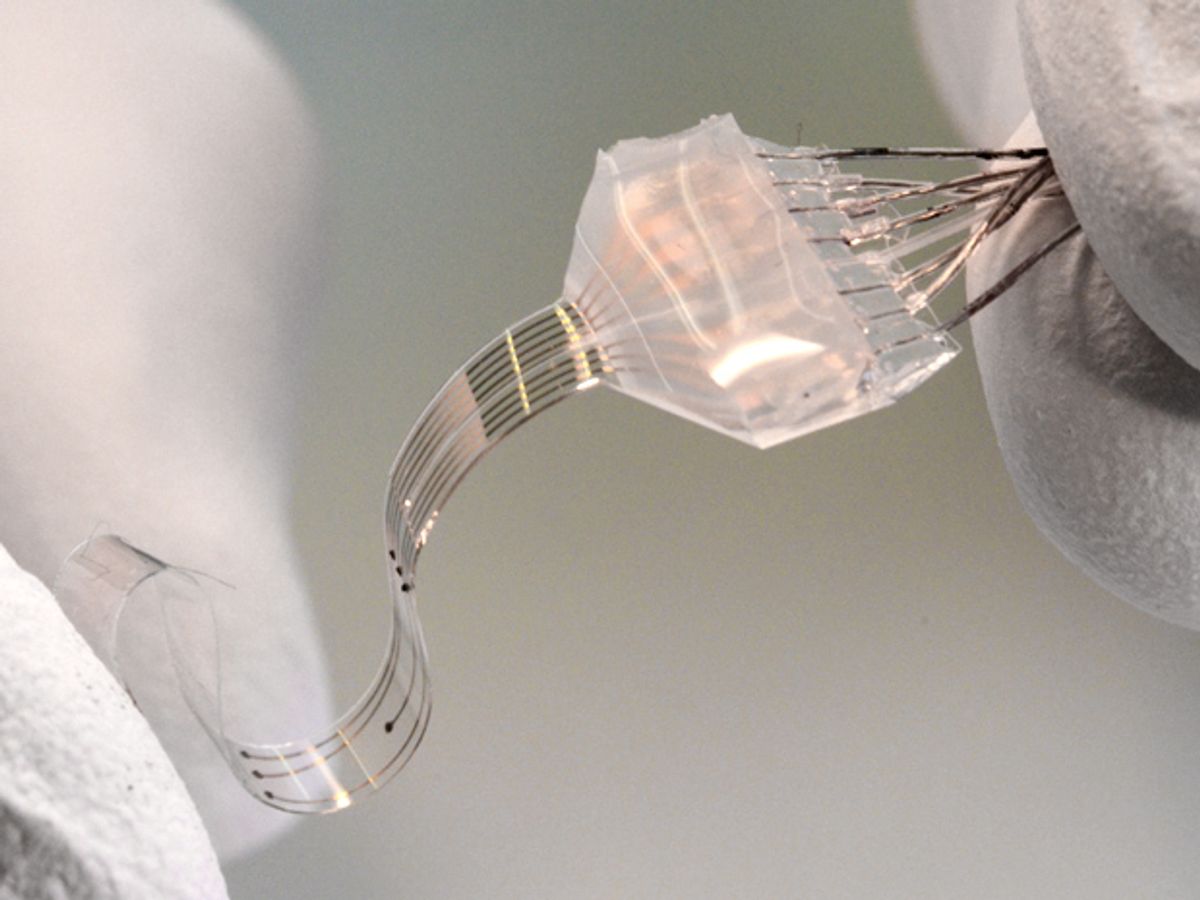If you need a piece of hardware attached to the delicate tissue of your brain or spinal cord, wouldn’t it be preferable for that piece of hardware to actually be soft, yielding, and flexible?
That kind of thinking led researchers at a Swiss technology institute to develop a new material modeled on dura matter, the protective membrane of the brain and spinal cord. Their “e-dura” contains stretchy electrodes that can both stimulate and record from neurons. When implanted in mice, the e-dura caused less damage and inflammation than today’s rigid implants. Researchers say their biocompatible material could be the key to long-lasting neural therapies.
Brain and spinal implants are no longer the stuff of science fiction. Thousands of people with Parkinson’s and epilepsy are walking around with stimulators implanted in their brains, and researchers are exploring the use of deep brain stimulation for depression and other neuro-psychiatric disorders. Spinal cord stimulation experiments have already enabled paralyzed people to stand, and may someday get them walking. Implants can also be used to record neural acitivity and use it to control external devices like prosthetic limbs.
But the body is a mechanically dynamic environment, says Stéphanie Lacour, one of the study’s lead authors and chair of neuroprosthetic technology at the École Polytechnique Fédérale de Lausanne (EPFL).
“The brain pulsates with blood flow, the spine cord stretches and relax with daily movements,” she told Spectrum. “Therefore an implant with a similar mechanical behavior to the neural tissue will provide a more suitable interface than a non-elastic implant.” The e-dura is designed to be placed on the surface of the spinal cord or brain, and isn’t suitable for penetrating implants used in deep brain stimulation.
Lacour and her colleagues started with a transparant silicone substrate, added gold interconnects with microcracks that make them stretchable while maintaining conductivity, and printed on soft electrodes coated with a platinum-silicone composite. Interestingly, they also included what they call a “chemotrode,” a tiny microfluidic component that can deliver drugs directly to the neurons.

To test their material, the researchers implanted the e-dura directly on rats’ spinal cords (beneath the real dura matter), and left it there for six weeks. They did the same with a stiff implant. They found that rats with the stiff implant began to have trouble walking within just a few weeks, and later examination showed both inflammation and deformation of their spinal cords. The rats with the e-dura implant displayed no such motor problems or physiological degradation.
The material must not only prove harmless, but also effective. The researchers showed both that the e-dura accurately recorded from and stimulated neurons in the brain and spinal cord. The stimulation experiment built on co-author Grégoire Courtine’s work at EPFL, in which he has enabled paralyzed rats to walk again through a combination of spinal cord stimulation and drugs. In the new experiment, the e-dura was placed on the spinal cord below the site of injury, and used to provide electric pulses and drug doses. Throughout the six-week implantation, the paralyzed rats walked and walked.
Courtine says the chemotrode element on the e-dura is an important advance, because delivering drugs only to targeted neurons could reduce doses five- or ten-fold. And lower doses mean fewer side effects, Courtine told Spectrum. For example, he pointed to Parkinson’s patients who take the standard L-dopa medication, which controls symptoms but can also cause muscle spasms and other disruptive side effects.
Other labs have produced similar biocompatible and elastic electronics, including Takao Someya of the University of Tokyo, who wrote for Spectrum about his work on e-skin. Someya commends the e-dura for creating an “intimate connection” with the spinal cord, and says it may produce more efficient therapies with its highly targeted delivery of electric pulses and drugs. “The challenge of their future work is to perhaps integrate more functionality into these devices, increase electrode densities, or tailor electrode placement to each specimen,” he says.
Eliza Strickland is a senior editor at IEEE Spectrum, where she covers AI, biomedical engineering, and other topics. She holds a master’s degree in journalism from Columbia University.



